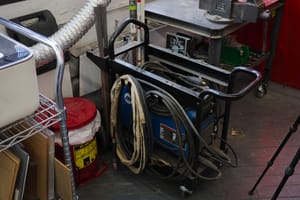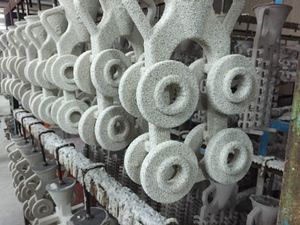There’s this guy in my neighborhood who I see every so often. He’s usually walking a dog with someone who I assume to be his spouse. They’re both a little older than I am, gen X or thereabouts, and his appearance is luxuriously shaggy. Chunky socks puff out between the straps of his Birkenstocks, and long, graying hair spills from his oversized beanie. I believe he wears eyeglasses, clear (yellowing?) frames and thick lenses, and is often layered in shirt over sweater over something else. And his pants are smudged, smeared, speckled with paint.
Few sartorial details speak to one’s profession as loudly as paint on one’s pants. The pants should be canvas, duck, or maybe denim, made by Dickies or Carhartt or maybe via a collaboration involving a streetwear brand. They might be cuffed over your Chelsea boots, or cut short and worn high on the hips. They might have a hammer loop, never used for its intended purpose (nobody uses hammer loops). Maybe they’re worn with clogs, and maybe they’re worn with Crocs, and maybe they’re worn with Chuck Taylors. Either way, paint-covered pants are likely to be the part of the ensemble which speaks the loudest.
Of course, having paint all over your pants is usually just one of many signifiers of your profession. On a recent morning during mid-winter break I sat, working, in a coffee shop after having dropped my kid off at day camp. It was cold, and the wifi was slow, and the coffee shop was filled with a stream of parents and their toddlers, the toddlers too young to enjoy six hours of magic camp and their parents happy to sacrifice a six dollar pastry if it meant they could sit down on a normally sized chair and kill twenty minutes. As the workday came into focus, the coffee shop’s dainty sheet metal tables were colonized by little labor units; I was one of them. A nearby table was occupied by two middle-aged men, engaged in what was obviously some kind of performance review. They were sitting in front and just to the right of me, at an angle that gave me an unobstructed view of the employee, who wore a beanie, a mustache floating vaguely over a field of stubble, and some of the paintiest pants I’ve ever seen. It was unclear who had requested this meeting. I suspected the employee, who referred to written notes, proclaimed sincerely and earnestly that “this” was what he wanted to do with his life, and dropped something at the end of the meeting about how he hoped that they might grow to work together “more as equals.” Even if there hadn’t been a large printing shop located prominently nearby, everyone in the coffee shop would have known: This guy worked with paint.
We broadcast our professional identities in so many clumsy ways. I do this too, only for the past four years my sincere and earnest proclamations have been less about the thing I’ve made my full-time job (writing this newsletter) than for the stuff I’ve done in the past. Over these four years, perhaps the most prominent example of this is the workshop I’ve occupied and managed – a light industrial space in Bed Stuy. I love the term light industrial; I love using it in sentences that refer to something that I do. I love mentioning the workshop’s size, two thousand square feet, which I like to think sounds respectfully large, business-sized. And I have loved having a respectfully large, business-sized box – a professional blank slate, covered with evidence of my labor.
I would say that this workshop has been a fantastic way to broadcast my professional identity, but the reality is that the professional identity in question has belonged not so much to me as to someone who I used to be. I love the work that gets done in workshops, and even as I pack my tools out of this particular light industrial space in Bed Stuy, I find myself planning out a series of increasingly ambitious projects to undertake. This is fine, good; I am someone who does projects in his free time. But a business-sized thing is too big for those purposes — and anyway, this newsletter does a better job of broadcasting my professional identity these days.
SCOPE CREEP.
- Oh man, I labored over whether to write “this guy works with paint” or “this guy works with ink.” The latter is probably more accurate – my honest suspicion is that his pants were covered with latex screen printing ink, which appears to be pretty rare. Here’s one manufacturer, whose products are cured by heating to 60°C.
- There is apparently a tradition – dormant for a few decades but alive and well in 2024 – of painting pictures onto tan-colored corduroy garments to commemorate the graduation from college or high school. This (gift link) NYTimes article summarizes the tradition and practice well: One’s time at said college or high school is reflected upon, and objects, phrases, and ideas are recalled, and these things are painted onto pants and jackets and kept as mementos and fashion pieces. The Indiana State Museum has some nice vintage examples of this tradition, dubbed Senior Cord, here.
- If we're being literal, I'm less likely to have paint on my pants than PL, a polyurethane construction adhesive commonly used to adhere plywood sheathing to floor joists. Its manufacturer, Henkel, recommends cleaning PL up with mineral spirits – an activity that strikes me as unpleasant and potentially not worth the effort. I did, however, enjoy this video of Henkel's testing facilities, which reminded me of that time circa 2011 when I spent a while trying to figure out which adhesives would be best for bonding mahogany to anodized aluminum, and silicone to anything at all. The mahogany-aluminum combination turned into its own little disaster (a story for a different day), but the discussions I had with Henkel employees about silicone were particularly enlightening. I had not to that point understood the idea of surface energy, which silicone tends to have very little of; this makes it very difficult to bond to. This 3M explainer includes a chart of common plastics, noting that PTFE has a surface energy around 18 Dyne/cm; silicone is slightly higher at around 24 Dyne/cm. In the end we used a surface primer (which raises surface energy) and a cyanoacrylate (commonly known as instant adhesive or crazy glue) to reasonably good effect.
Thanks as always to Scope of Work’s Members and Supporters for making this newsletter possible. Thanks also to Ethan for helping provide links this week.
Love, Spencer.



